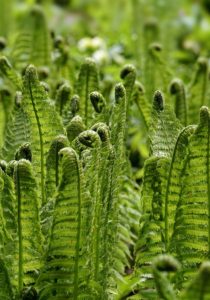Some links in the post are affiliate links and I get a commission from purchases made through some links found in the post.
Imagine this. The first frost is nigh and you decide to protect your fern by moving it indoors which seems like a great idea at the time.
You set the potted plant near a well-lit space and leave it to thrive in the indoor space. A few days later, you water the plant.
No sooner has the water filled the pot than you get a whiff of a terrible smell that almost knocks you backwards.
It seems to be emanating from the fern plant and as you get close to the pot, you get a whiff of a fish smell. Where could that odour be coming from?
Today, we will cover some common reasons why your fern may smell like fish or emit other sickening smells. Here goes:
Why Does Your Fern Smell Like Fish?
Thinking that your Fern plant creates a smell like fish can be quite discerning.
After all, the plant should aid in fresh air circulation and should not be the reason you need an air freshener in your home.
Interestingly, while you may think that the plant is to blame for this horrible smell, that is not quite the case.
Your soil is the culprit! You see, fresh soil generally gives off an earthy scent that makes you feel grounded and tied to mother earth.
However, once it starts emitting smells such as those that come from fish, it is likely that all is not well in the soil.
 Usually, it all comes down to waterlogging which creates a host of problems as we will later cover.
Usually, it all comes down to waterlogging which creates a host of problems as we will later cover.
Thus, it helps to note that your plant is not to blame and the easiest way to deal with the odour is to address the soil.
Now, how does water make your soil smell bad? Healthy soil contains air pockets that help the plant roots in breathing.
When the soil has too much water, these air pockets fill with water, creating an environment where the plant roots cannot thrive; also referred to as an anaerobic environment.
Such conditions are ideal for the growth of harmful bacteria that emit the smells you get.
How to Stop your Fern from Having a Smell like Fish
Now that you know that waterlogging is the likely problem, the key lies in checking your watering habits.
Also, it helps to check the state of your soil and the weather conditions in which you live as follows.
General Assessment
Seasons
If you leave your plant outside during the rainy season, it is likely to receive much more water than it needs, which can lead to a toxic soil environment.
You should either move the plant or find a way to reduce the amount of water it gets during this season.
Soil Structure
Soils are not the same. If you use heavy clay soil in your pot, you will notice that it will hold water for longer owing to its poor drainage.
It is thus in your best interests to find aerated and loosely packed soil for your plant.
Overwatering
Sometimes, the problem lies in your watering habits. The more water you give to a waterlogged plant, the easier it becomes for carbon dioxide and ethylene to build up around the plant’s roots.
Over time, root growth reduces and this, in turn, hampers the growth rate of the plant.
Leaching
The more water you give to a plant, the more nutrients leach from the soil. This continuous loss weakens a plant and makes it susceptible to pest and disease problems.
If any of the above problems are to blame for the waterlogging problem, the following signs will show in the affected fern.
If you’re enjoying this article, check out our article on how to stop your Boston fern leaves from curling.
Signs of Waterlogging
Leaf Changes
As more nutrients leach from the soil, the fern leaves may start discolouring and could turn yellow. They may also start wilting and dying back as their leaves soften.
Algae Growth
You may also notice a build-up of algae at the top of the soil, pointing to microbial activity in the affected soil. This growth can also be present in ferns growing in the garden.
Worms
If worms start showing up at the surface of the soil, it indicates that the conditions below the soil surface are not ideal.
The worms can no longer survive in that unoxygenated state and they need to remain on the surface if they are to live.
Weeds
The anaerobic environment created by the lack of oxygen contributes to the growth of weeds such as docks.
If you find that you are dealing with more weeds than usual, waterlogging could be to blame.
Smells
The soil can emit a range of smells from sour to urine-like to fish to musty. People describe the changes in their soils in different ways but they all point to this toxic soil environment.
Water Collection
You may also find that the soil collects water at the top, and this water does not seem to drain at any point, showing that it is saturated.
You may also like: Can I grow ferns in water only
Pests & Diseases
In a toxic environment, a plant cannot thrive. As such, you will notice that your fern has become much more susceptible to pests and diseases.
Where you find yourself looking for pesticides more often than you did in the past, waterlogging might be the problem.
Root Rot
 Unfortunately, root rot is not easy to diagnose from the outside and it often destroys the plant by the time it becomes noticeable.
Unfortunately, root rot is not easy to diagnose from the outside and it often destroys the plant by the time it becomes noticeable.
You may notice a change in leaf colour and form in the beginning. If you do not act on it fast, the rot may completely kill the plant by taking away its ability to absorb nutrients and water.
The easiest way to check for root rot is to pull a plant up and check the roots. If they appear discoloured and soggy, you have a problem in your hands.
Treating your Waterlogged Plant
Your soil is to blame for the terrible smell and there are several ways to deal with this problem as follows:
Cleaning
You need to hose off any residues on the plant leaves. For this, you can use a hose at pressure relative to the size of the plant.
You also need to get rid of any sludge that has accumulated at the top of the soil. Please wear protective gear for this to ensure you do not come into contact with any toxins.
Combine the waste material, bag it and put it in a bin where it cannot contaminate other plants in your home.
Scrubbing
Prepare a warm soapy water solution and use this to scrub the outside of the pot to get rid of any toxins.
Make sure the soap is environmentally friendly as porous pots can absorb it and transfer it to the already unhealthy soil.
Repotting
Start by removing all the contaminated potting soil and use it in a hot composting system to get rid of the pathogens.
All this while, you should wear gloves and a face mask to protect yourself from coming into contact with the toxins.
Clean the inside of the pot and add a fresh potting mix to it. For added aeration, please include worm castings and vermiculite.
Before returning the affected plant to the pot, remove any dead shoots or foliage with clean tools, ensuring that you practice a high standard of hygiene in the process.
Replenishing
If repotting does not work for you, try adding microorganisms back into the soil to see if its state improves.
Good examples include fresh compost and worm castings added to the top layers of the soil.
Ensure that you do not disturb the roots as this can further weaken the plant. Keep adding these treatments every two weeks until you notice an improvement in the soil.
Watering
Given that this problem started with overwatering, it would be ideal to ensure that you keep moisture levels at an optimum level.
Using a moisture meter enables you to check how much water is in the soil at any given time. Ideally, the level should be at 40%-70%.
Anything more than 70% reduces the oxygen available in the soil, creating a toxic environment.
Anything lower than 40% can cause wilting and can make it hard for the plant to absorb nutrients.
Drainage
Your pot should not only have aerated, well-draining soil but should also have adequate drainage holes at its base.
Ensure that nothing blocks these holes such that water can drain freely.
Frequently Asked Questions
Why do Some Ferns Smell like Urine?
 Your plant may smell like urine owing to waterlogged soil or because your pets have been using the fern as a loo.
Your plant may smell like urine owing to waterlogged soil or because your pets have been using the fern as a loo.
Where pets are to blame, hose the plant down on its side before setting it upright and allowing it to rest for half an hour.
Next, fill a spray bottle with half a teaspoon of tea tree oil and a cup of room temperature water.
Combine the ingredients well and direct the spray to the base of the fern, ensuring that you soak the top layer with the mixture. Tea tree’s smell will mask the smell of the urine.
Where waterlogging is to blame, please refer to the first section of this post.
Why Does your Fern Smell Musty?
A musty smell indicates overwatering and fungal growth.
You can easily solve this by repotting the plant and changing your watering habits as covered in our first section.
Why Does your Fern Smell like Rotten Eggs?
Root rot is the likely cause of your fern smelling like rotten eggs, owing to a toxic environment created by lack of oxygen in the soil.
Repotting should solve this. Please refer to the first section of our post.
The good news is that any horrible smells coming from your fern likely owe to the state of your soil.
As such, a few changes to your watering habits and a change of potting soil should be enough to get rid of the stench. Happy Gardening!
Before you go, here are some more related articles I encourage you to read below to help solve more of your gardening issues:
How to Grow Asparagus Ferns from Tubers
How To Save A Dying Staghorn Fern

